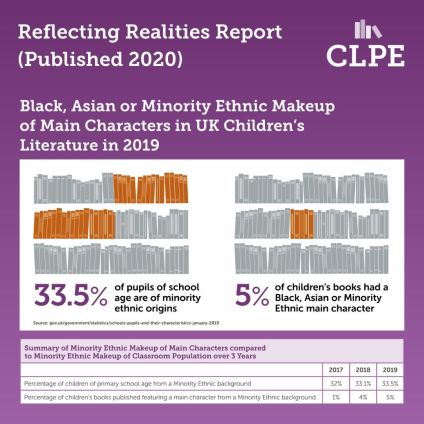Yesterday both CLPE and Book Trust released their most recent research into representation of authors and characters from ethnic minorities in British children’s literature. This is important work, creating a base of data that can be used to support writers and create better literature for children. Read them here:
https://clpe.org.uk/aboutus/news/announcing-clpes-reflecting-realities-third-survey-ethnic-representation-uk-children%E2%80%99s
The general conclusion both reports draw is that while there has been an improvement in representation of authors (Book Trust Represents) and characters (CLPE) of colour, there is much work still to be done. I’ve read both reports and here are my reflections.

Debut creators of colour are embarking on an exciting but very difficult journey
“There has been a clear increase in the number of debut British creators of colour published since 2007. The number more than doubled from 10 debut creators of colour in 2007 to 24 in 2019.” – Book Trust Represents
More people of colour being published for the first time in children’s literature is a very good thing, but context and detail is all. Book Trust also reported the important fact that:“It is important to note that a large proportion of these debut creators continued to be self-published/published by a hybrid publisher”
Although there are benefits to being self/ micro published, self-publishers and those published by very small presses, may experience more barriers to reaching wide audiences and high sales. It is therefore concerning if the increase in debut creators of colour is mostly in these areas.
Overall, opportunities for anyone to be published in children’s and YA literature are apparently narrowing:
“…there has been a steady decrease in the number of all titles, unique titles and number of creators since 2015. This decline in the number of titles and creators being published continued in 2018 and 2019.” – Book Trust Represents
The natural publishing timeline means that many authors and creators who were first commissioned back in 2017, 2018 are releasing their debut books in 2020 – the year of the pandemic, disruption in schools and libraries, closed bookshops, cancelled school visits and many other factors making it harder than ever for debut authors to be discovered by readers. Moreover, the impact of Covid-19 on ethnic minorities has been especially high. This is a challenging time to be a debut creator of colour.
One of my tutors on the creative writing MA at Warwick once told me: “It’s not getting published that’s the problem; it’s staying published.” As an unpublished writer, I didn’t understand this. Fifteen years later, I most certainly do. An steady increase in debut creators is great. A steady churn of debut creators – where your first contract is your last – is not. It’s not yet clear which we are seeing. To make long-term change, publishers will need to make long-term investments in and committments to creators of colour so they can not just start, but sustain, a career.

British writers of colour are under-represented: a minority within a minority?
The latest figures from Dr Melanie Ramdarshan-Bold’s research into representation of people of colour as writers of YA literature, showed a steady increase since 2017, with the percentage of YA authors of colour at nearly 20% in 2019. Yet UK YA writers of colour were a mere 5.95%. Similar statistics are evident today in Book Trust’s interim report which covers all age groups: a rise in people of colour creating children’s and YA books, from 5.58% of creators (2017) to 8.68 % (2019), but 1.98% (2017) to 2.86% (2019) when you count only British creators.
Why does this matter? Well firstly because the preponderance of authors from elsewhere than the UK strongly suggests that publishers are choosing to buy in ‘oven-ready’ books from a different country rather than nurture writers here in the UK . That is a quick fix, not systemic change. It does not empower emerging UK writers of colour. In fact, it may take one of those diminishing opportunities to be published away from them. Publishers should consider looking down the street before they look across the pond.
Secondly, young UK readers need books that reflect their lives in all their regional diversity. Of course we want to see children’s books from all over the world, but not if it continues to present a narrative in which those with brown skins are foreigners. One of the great things about Danielle Jawando’s AND THE STARS WERE SHINING BRIGHTLY was its setting in Wythenshawe. Children’s literature needs to celebrate the diversity of people of colour of all backgrounds, classes and in all regions of the UK.
In conclusion, it’s great to see the improvements, but I don’t see evidence of significant systemic change happening yet. The important reports published yesterday are part of a process . I look forward to following the research through years to come so we can get a clear image of where we are, and a map of where we want to be.
Leila Rasheed


It’s so important to have these facts and statistics. But it’s terribly sad that so few British writers in particular are coming through, let alone through mainstream publishers.